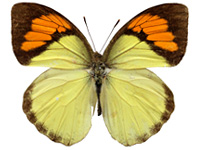
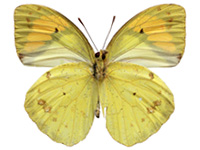
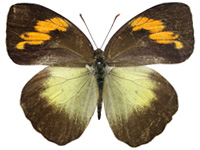
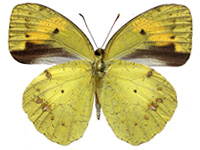
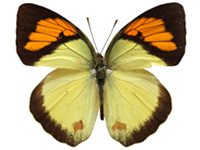
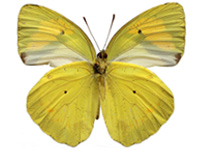
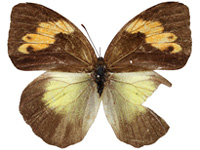
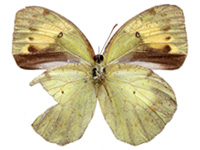
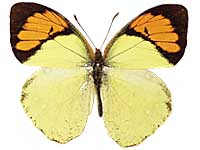
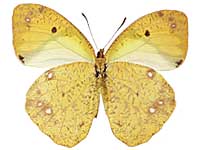
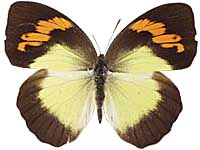
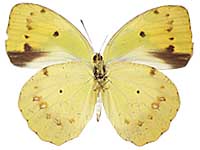
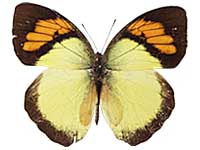
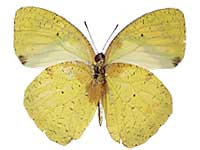
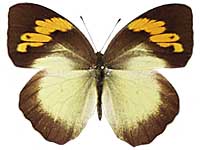
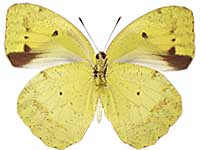
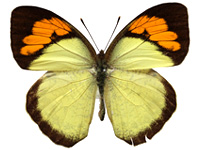
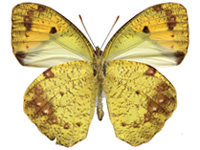
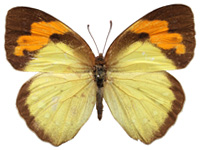
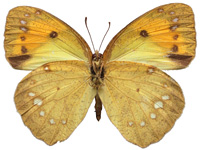
 |
 |
 |
 |
| ♂, Ninh Binh, Vietnam. | ♀ (wsf), Phong Saly, Laos. | ||
 |
 |
 |
 |
| ♂, Ninh Binh, Vietnam. | ♀ (wsf), Nan, Thailand. | ||
 |
 |
 |
 |
| ♂ (dsf), Mae Hong Son, Thailand. | ♀, Nan, Thailand. | ||
 |
 |
 |
 |
| ♂, Chiang Mai, Thailand. | ♀, Nan, Thailand. | ||
 |
 |
 |
 |
| ♂, Mae Hong Son, Thailand. | ♀ (dsf), Chiang Mai, Thailand. | ||
| ON :
Ixias yunnanensis Fruhstorfer, 1902 OD : Soc. ent. 17(11): 81. TL : "Mengtze" [Mengzi], Yunnan. (NHML) Distribution : Yunnan, N.Thailand, Laos, N.Vietnam.
|
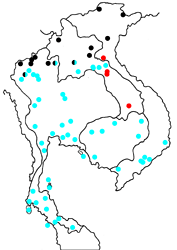 |
Ixias pyrene tonkiniana Fruhstorfer, 1903 : Deut. ent. Zeit. [Iris] 15: 297. TL. "Tonkin" [N.Vietnam]. (NHML)
yunnanensis ; ♂, Type (red), Mengtze, Yunnan. (NHML, examined)
tonkiniana ; 1♂ 1♀, Type (red), Juni-Juli. Than Moi, Tonkin. (NHML, examined)
[ THAILAND ]
Ixias pyrene latifasciata ; Nishimura,2000 : 175-179, figs.55-56,(seasonal variation),59(map),60a(♂genitalia). (Chiang Mai: Chiang Dao; Nan: Pua)
Ixias pyrene verna ; Ek-Amnuay,[2007] : pl.51, figs.39a♀(middle-center),♀(Un,middle-right). (in part)
Ixias pyrene yunnanensis ; Ek-Amnuay,[2007] : 158, pl.52, figs.Pi39b♂(dsf),♂,♂,♂(dsf,Un),♂(Un),♂(Un),♂[♀](dsf),♀(dsf,Un),♀(wsf,Laos). (Fang; Mae Hong Son; Nan: Doi Phu Kha)
Ixias pyrene latifasciata ; Kimura et al.,2011 : 153, figs.♂,♂(Un),♂,♂(Un). (Doi Pha Hom Pok; Doi Chiang Dao; Doi Phu Ka)
Ixias pyrene verna ; Ek-Amnuay,2012 : pl.51, figs.Pi39a♀(middle-center),♀(Un,middle-right). (in part)
Ixias pyrene yunnanensis ; Ek-Amnuay,2012 : pl.52, figs.Pi39,♂(dsf),♂,♂,♂(Un,dsf),♂(Un),♂(Un),♀,♀(Un). (in part)
[ LAOS ]
Ixias pyrene f. pyrene ; Dubois & Vitalis,1921 : 21. (Thado)
Ixias pyrene f. rhexia ; Dubois & Vitalis,1921 : 21. (Laos)
Ixias pyrene f. tonkiniana ; Dubois & Vitalis,1921 : 21. (Laos)
Ixias pyrene f. denigrata ; Dubois & Vitalis,1921 : 21. (Laos)
Ixias pyrene yunnanensis ; Motono & Negishi,1989 : 50, col.pl.12, [fig.♂, as Ixias pyrene verna] ; pl.23, figs.7♂,8♂(Un) ; pl.24, figs.1,♂,2,♂(Un),3,♀,4,♀(Un). (Nam Moh; '? Vientiane'; Luang Prabang; '? Pakse'; Tha Dua)
Ixias pyrene yunnanensis ; Osada, Uémura & Uehara,1999 : 202, pl.36, figs.♂(dsf),♀(dsf),♂(dsf,Un),♀(dsf,Un),♀(Un),♂,♂,♀,♀. (Phong Saly; Oudomxay)
Ixias pyrene latifasciata ; Nishimura,2000 : 175-179, figs.59(map). (Houa Phan: Xam Neua; Viang Chan: Vang Vieng; Ban Na Ruwang; Xiang Khoang: Ban Nok; Ban Nam Hom; Xaigna Bouri: Doi Pee Ban Nam; Luang Nam Tha: Nam Ha; Namtok Nam Di)
Ixias pyrene latifasciata ; Nakamura & Wakahara,2012 : 42.
Ixias pyrene latifasciata ; Onodera,2022 : 17, pl.67, figs.♂,♂(Un),♀,♀(Un),♀,♀(Un). (Vientiane: Vang Vieng; Houaphan: Phou Pan; Bolikhamxai: Houay Phet)
[ VIETNAM ]
Ixias latifasciatus ; Joannis,1901 : 329. (Tonkin: Cao Bang)
Ixias pyrene tonkiniana ; Fruhstorfer,1910 : 158. (Tonkin)
Ixias tonkiniana ; Vitalis,1919 : 219. (Tonkin)
Ixias pyrene f. tonkiniana ; Dubois & Vitalis,1921 : 21. (Tonkin)
Ixias tonkiniana ; Lemée,1950 : 5. (Hagiang) (in part)
Ixias pyrene tonkiniana f.aest. tonkiniana ; Metaye,1957 : 86. (N)
Ixias pyrene tonkiniana ; Ikeda et al.,1998 : 19, figs.6:12,♂,13,♀,14,♀(wsf),15,♂,16,♀(dsf),10:31(♂genitalia). (Cuc Phuong)
Ixias pyrene latifasciata ; Nishimura,2000 : 175-179, figs.17-18(tonkiniana,HT,♂), 19-20(tonkiniana,ST,♀), 21-22(denigrata,ST,♂),55-56(seasonal variation). (Ha Nam Ninh: Cuc Phuong)
Ixias pyrene yunnanensis ; Luong et al.,2004 : 2, 33, figs.♂,♂(Un),♀,♀(Un). (Cuc Phuong)
Ixias pyrene yunnanensis ; Monastyrskii & Devyatkin,2015 : 17. (N)
Ixias pyrene yunnanensis ; Monastyrskii,2024 : 93-96, pl.25, figs.a♂(wsf),b♂(Un,wsf),c♂(dsf),d♂(Un,dsf),e♀(wsf),f♀(dsf). (N: Cao Bang; Muong Nhe; Ba Be; Na Hang; Huu Lien; Kim Hy; Cat Ba; Ba Vi; Cuc Phuong; Pu Luong; Tam Dao; Xuan Son; Ben En)
[ THAILAND ]
Mae Hong Son : 20♂ 1♀.
| Jan | Feb | Mar | Apr | May | Jun | Jul | Aug | Sep | Oct | Nov | Dec |
| Jan | Feb | Mar | Apr | May | Jun | Jul | Aug | Sep | Oct | Nov | Dec |
| Jan | Feb | Mar | Apr | May | Jun | Jul | Aug | Sep | Oct | Nov | Dec |
| Jan | Feb | Mar | Apr | May | Jun | Jul | Aug | Sep | Oct | Nov | Dec |
The butterfly is locally common in montane forests at moderate to high elevations (Alt. 550 - 1600m).
Both sexes visit flowers, and males often come to the banks of streams and puddles to suck water.
This taxon is highly variable with individual and seasonal variation and quite hard to distinguish the geographic variation, especially in the Indochina region.
Furthermore, as mentioned in ssp.verna, there are also transitional and intermediate forms with verna, making identification even more difficult.
Nishimura (2000), like D'Abrera (1982), treated all taxa of this area except verna as synonyms of latifasciata.
However, I believe that there are four major populations in Myanmar as follows;
1. The populations similar to Indian ssp.sesia and ssp.familiaris in Kachin State (north of Mytkyina, especially west of the Irrawaddy River).
2. The populations similar to ssp.yunnanensis from S.Kachin State (Bhamo) to Shan States and northern Karen Hills.
3. The populations from Moulmein to Tenasserim, south-central Karen Hills, mainly west of the Salween River, are thought to be ssp.latifasciata.
4. The taxon verna, as in 3, appears mainly east of the Salween River from the Dawna range to Tenasserim, and occasionally occurs in Karen Hills to S. Shan States.
Gabriel (1943), discusses latifasciata, including the issue of the type locality, which was given as Moulmein in the original description.
As Gabriel mentioned, the syntype female seems to be from Moulmein, but the male is rather different from the average of populations of this area.
He presumed that the male was not from Moulmein, but from the more westerly area around "Rangoon" [Yangon].
I agree with him that the male was not from Moulmein, but think it is more likely to be from further north around Taungoo, S. Karen Hills.
If it is in the Taungoo area, it could be a different taxon from the female.
Here, I tentatively consider Moulmein as the type locality of latifasciata, and following Gabriel, I treat moulmeinensis and meipona as its synonyms.
The taxon meipona is a transitional individual to the yellow form from verna as well as fruhstorferi in Vietnam and Laos, and its coloration is highly variable and unstable.
It is frequently found from Moulmein to Tenasserim and southern Karen Hills, and is considered a transition zone.
Although ssp.verna is distributed in almost the same area as latifasciata, it tends to be more common east of the Salween River and latifasciata is more common west of it.
However, verna overlaps habitat with latifasciata depending on the environment and has been found in Tavoy, Dawna range, Moulmein to Tenasserim, Ataran, Karen Hills etc.,
with intermediate individuals to the yellow form found in various locations.
The taxon yunnanensis is slightly larger than ssp.latifasciata.
The females of the rainy season form have enlarged black areas on upperside of both wings.
In particular, the UpF tends to be mostly black except for the subapical band.
Meanwhile, in wet season form females of latifasciata, the blackening is almost exclusively in the cell of the UpF, and spaces 1 to 3 are not entirely covered with black.
Such populations are found in C. to S.Yunnan, Myanmar (Bhamo, S. Kachin, Shan States and N. to C. Karen Hills), N. Thailand, N. Laos and N. Vietnam, all of which I tentatively treat as ssp.yunnanensis.
Further distributional research and taxonomic studies including DNA analysis are needed.
Fruhstorfer, H.,1902 : Neue ostasiatische [sic] Rhopaloceren.
Soc. ent. 17(11): 81-82. (1.Sep.1902)
Fruhstorfer, H.,1903 : Verzeichniss der in Tonkin, Annam und Siam gesammelten Pieriden und Besprechung verwandter Formen.
Deut. ent. Zeit. [Iris] 15(2): 269-305. (1.May.1903)
Fruhstorfer, H.,1910 : 2. Familie: Pieridae. In: Seitz, A. (Ed.), Die Gross-Schmetterlinge der Erde.
9: 153-168 (2.Apr.1910), Stuttgart, Alfred Kernen.
Gabriel, A.G.,1943 : A revision of the genus Ixias Hübner (Lepidoptera: Pieridae).
Proc. R. ent. Soc. Lond. (B)12(5/6): 55-70.
D'Abrera, B.,1982 : Butterflies of the Oriental Region Part 1 Papilionidae, Pieridae & Danaidae.
xxi + 244 pp, Australia, Hill House.
Nishimura, M.,2000 : The geographical races of Ixias pyrene (Lepidoptera, Pieridae) mainly from the continental part of SE Asia, with special reference to intermediates between subspecies latifasciata and verna.
Tyô to Ga 51(3): 169-184.
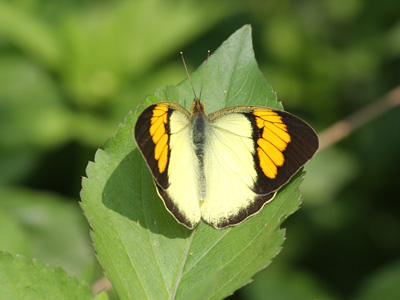 |
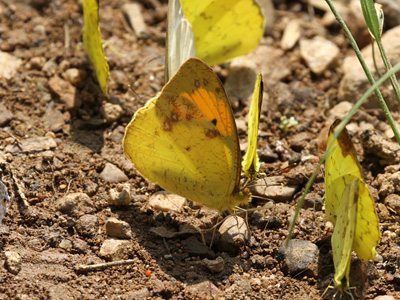 |
| ♂ (dsf), Chiang Mai, Thailand. | ♂ (dsf), Chiang Mai, Thailand. |
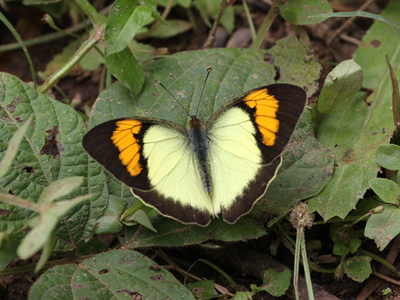 |
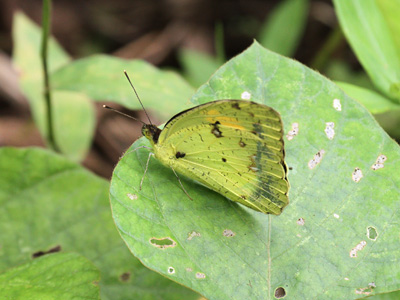 |
| ♂ (wsf), Chiang Mai, Thailand. | ♂ (wsf), Chiang Mai, Thailand. |
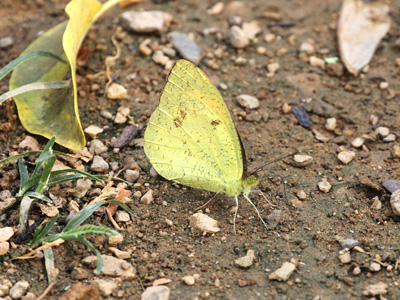 |
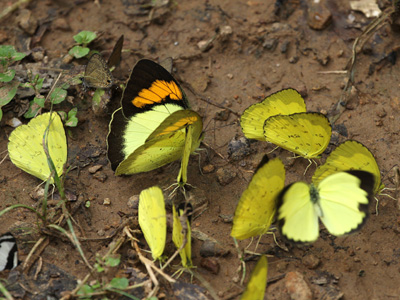 |
| ♂ (dsf), Chiang Mai, Thailand. | ♂ (wsf) with Eurema spp., Chiang Mai, Thailand. |
|
1996.10.31 - 2025.04.30.
|